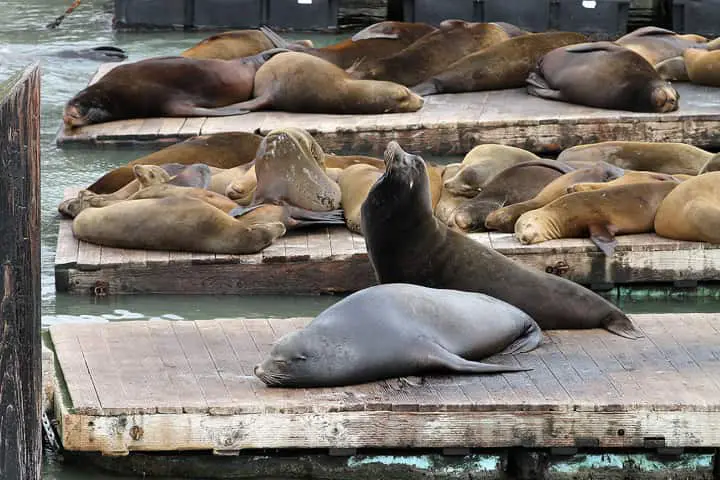
California sea lions numbering hundreds bask in San Francisco, US (Pic. Courtesy wikimedia jcommons)
Nature continues to surprise scientists in more than one way. While most animals, when their numbers go up, become smaller in size because of competition for food, California sea lions are showing a reverse trend.
As per a smithsonianmag.com report, these marine mammals – a coastal eared seal native to western North America – after receiving federal protection for 50 years have thrived. Yet, they have grown larger instead of becoming smaller, said a study published in the journal Current Biology.
The 1950s saw their number dwindle due to bounties, hunting and pollution. The passing of Marine Mammal Protection Act in 1972, which made harassment, killing, capturing and hunting of these animals illegal, made their numbers go up slowly. From 10,000 then, they have become today 2,57,000 in the wild with the International Union for Conservation of Nature listing them as “least concern”.
Keen to understand why their physical size was becoming bigger, scientists from Santa Cruz’s University of California and Smithsonian’s National Museum of Natural History closely studied more than 330 sea lion skulls. Collected between 1962 and 2008 from the Northern and Central California coast, they had been kept in different museums.
Sea lions playing in huge waves near Santa Barbara in California
🎥 Ryan Lawler ( for Pacific Offshore Expeditions ) pic.twitter.com/eHclZ4RjqM
— Gabriele Corno (@Gabriele_Corno) August 29, 2022
They found the skulls of males had become a few millimetres bigger and this translates to a ten-centimetre increase in body size. On the contrary females had not grown as they had no incentive to do so.
The males who were polygamous and needed to fight for mates and territory required size. Stronger and bigger ones had the natural edge over others. Also, bigger blubber allowed them to go without food for longer duration.
Commenting on this aspect, Elliott Hazen, National Ocean and Atmospheric Administration’s research ecologist, who was not part of the research said: “Larger males are simply more successful on the beaches. They compete for mates on the beach, increasing their sexual dimorphism and increasing pressure for larger body sizes and skulls as reported in this study.”
While females can grow 6 feet long and weigh 109 kilograms, males can measure 7.5 feet and be 317 kg in weight.
Males were not choosy or picky eaters and looked for a diverse diet. This flexibility in diet is advantageous during food source disruption, said Ana Valenzuela-Toro, the study’s co-author and ecologist at UASC. This habit provides a size advantage too. “I think of California sea lions as the raccoons of the sea. They can eat many different prey, ranging from small pelagic fishes like sardines and anchovies to larger rockfish, salmon, squid or even octopus,” remarked Valenzuela-Toro.
About their future, scientists felt that they too will struggle because of climate change. Primarily dependent on sardines and anchovies, they will face difficulty when these decline with increase in ocean temperature.
Speaking about this, Valenzuela-Toro observed: “It will be a really hostile environment for California sea lions, and eventually we expect that their population size will stop growing and actually decline.”















